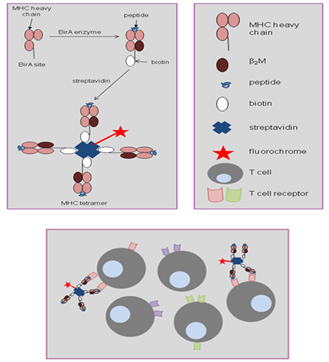MHC Tetramer
MHC tetramers have become widely available and easily accessible tools for the study and characterization of antigen-specific T cells at the single-cell level, thus surpassing detection limits of traditional cell-based methods. Tetramers consist of soluble MHC proteins complexed with a peptide, and are an efficient and easy way to identify, isolate, and study antigen-specific T cells from a variety of biological samples.

Principle of Detection Antigen- Specific T Cells by MHC Tetramer
Cells play an important regulatory role in the adaptive immune response of tumors, viruses, bacteria, parasites, transplanted tissues, allergens and even autoantigens. Stains using soluble MHC monomers were unsuccessful due to the low binding affinity of T-cell receptors and MHC-peptide monomers. This is necessary in order to allow each TCR molecule to bind multiple MHC-peptide complexes, and is the reason for the development of tetramers. When multimerized, the MHC complex/TCR interaction becomes more stable as the tetramer can bind multiple TCRs on the cell surface, in turn increasing the TCR binding affinity and decreasing the dissociation rate. That‘s to say,whilst single MHC:peptide complexes and TCR bind weakly, MHC tetramers can bind up to four TCRs simultaneously, creating a much stronger interaction. In addition, the analysis of antigenic specific T cells in vitro can be successfully realized by flow cytometry.Preparations of MHC Tetramers
MHC tetramers are made of 4 biotinylated MHC complexes, loaded with the peptide of interest (8-10 amino acids for MHC-I; 14-20 amino acids for MHC-II). The production of MHC class I tetramers is shown in the figure below. First MHC heavy chains expressing a bacterial BirA-recognition site are synthesized. The MHC heavy chain is then folded with β2-microglobulin (β2M; the MHC light chain) and synthetic peptide. The enzyme BirA is then added to biotinylate the complex, adding a biotin molecule to each MHC monomer that is formed. In the presence of streptavidin which has four biotin binding sites per molecule, four MHC monomers are joined together to form a tetramer. MHC class II tetramers can be produced broadly by two methods: the first method is analogous to MHC class I tetramers, by expression of the insoluble denatured subunits in E. coli inclusion bodies, followed by solubilization and in vitro folding in the presence of peptide, purification, biotinylation and tetramerization. Another method is to coexpress the α- and β-subunits, for example, in mammalian or insect cells. In some cases, a fusion protein is produced, consisting of peptide fused to the MHC class II β N-terminus via a linker region. The covalently attached peptide has access to the peptide-binding site and is able to bind to the peptide-binding groove, stabilizing the construct.
Application of MHC Tetramers
MHC Tetramers is widely used in cancer, infection and autoimmune diseases now. Compared with other methods used in T cell detection, such as intracellular cytokine staining (ICS), enzyme-linked immunospot detection (ELISPOT), etc. MHC tetramer technology has high sensitivity, high specificity, high stability, etc.- General staining--- High-throughput analyses;
- Tracking antigen-specific T-cell populations--- Track frequencies of CD8+ or, more rarely, CD4+ T cells in the circulation over time;
- Tetramer-guided epitope mapping--- Identifying specific peptides from an antigen;
- Combined tetramer & functional assays--- Proliferation, antiviral functions and phenotypic analyses;
- In situ tetramer staining --- Visualize antigen-specific CD8+ T cells in tissue with their spatial relationship to other intact cells;
- Adoptive T-cell transfer--- The selective isolation of functionally active antigen-specific T cells;
- Sorting antigen-specific T cells;
Ready-to-Use MHC Tetramer Provided by ITI BioChem
ITI BioChem has various MHC class type labelled with PE, APC, FITC, BV421, etc: HLA-A, -B, and -C, nonclassical HLA antigens encoded in each region include HLA-E, -G and-F in the MHC-I region and HLA-DR in the MHC-II region. In addition, ITI BioChem can provide a broad portfolio of MHC alleles, including: Human, Mouse, Rhesus Macaque, Macaca Fascicularis, etc;
Negative control MHC tetramer and MHC Monomers, biotin labeled;
HLA-A * 01:01,HLA-A * 02:01,HLA-A * 02:03,HLA-A * 03:01,HLA-A * 11:01,HLA-A * 24:02,HLA- A * 24:07,HLA-A * 25:01,HLA-A * 29:02,HLA-A * 30:02,HLA-A * 36:01,HLA-A * 68:01,HLA-A * 68:02
HLA-B * 07:02,HLA-B * 08:01,HLA-B * 14:01,HLA-B * 15:01,HLA-B * 15:02,HLA-B * 15:09,HLA- B * 18:01,HLA-B * 35:08,HLA-B * 39:06,HLA-B * 41:01,HLA-B * 44:02,HLA-B * 46:01,HLA-B * 55:01,HLA-B * 57:02
HLA-C * 03:04,HLA-C * 05:01,HLA-C * 06:02,HLA-C * 07:02
H-2Kb以及mCD1d、hCD1d;
Empty loadable MHC Tetramers: you can instantly DIY your own Tetramers in a matter of minutes simply by adding a specific peptide antigen
H-2Kb、HLA-A*02:01、HLA-B*07:02、HLA-A*11:01、HLA-A*02:01、HLA-A*24:02、HLA-A*03:01、mCD1d、hCD1d
QuickSwitch Tetramer Kit
The unique peptide exchange reaction technology that we possess can help you prepare tetramer reagents in the laboratory, reducing time and cost with this kit to create your own custom tetramers. The resulting custom tetramers can be used for multiple applications, including screening immunogenic peptides.
HLA-A*02:01、HLA-A*24:02 and H-2Kb;
PE、APC and BV421 labeled;
Custom Tetramers
You just need to provide your allele/peptide of interest: peptide sequences are subject to prior evaluation by ITI BioChem for binding;
If the assessment results are available, we will synthesize both the peptide and MHC tetramer reagent; If the results are unqualified, however, you have requirements for synthesis, you need to bear the cost of the failure of the MHC tetramer synthesis;
Please inquire us for detail if you want bulk products